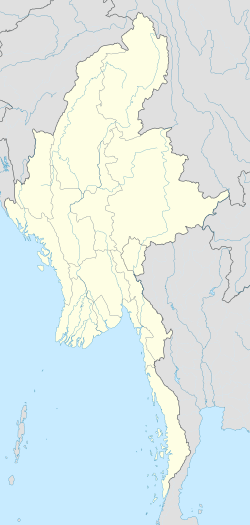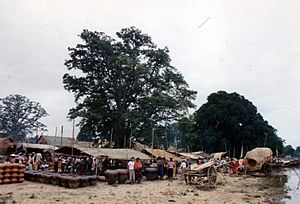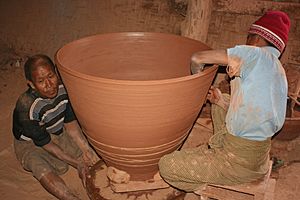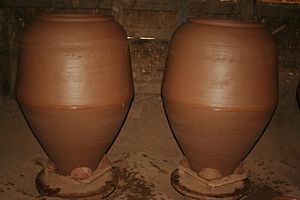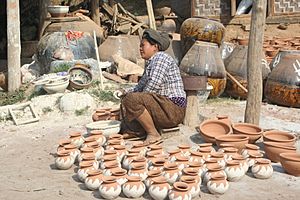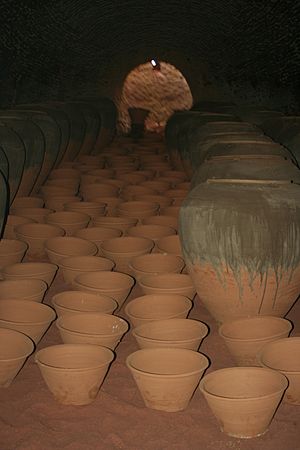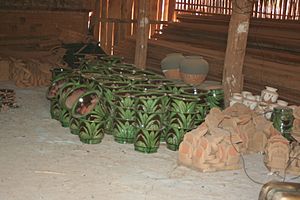Kyaukmyaung (Sagaing) facts for kids
Quick facts for kids
Kyaukmyaung
|
|
|---|---|
|
Town
|
|
| Country | |
| Division | |
| Population
(2015)
|
15,000 |
| • Religions | Buddhism |
| Time zone | UTC+6.30 (MST) |
Kyaukmyaung is a town in Sagaing Division, Myanmar. It is located about 46 miles north of Mandalay. The town sits on the west bank of the Irrawaddy River. Kyaukmyaung is known as a pottery village. Most of its 15,000 residents work in the pottery industry. It is home to the only four large glaze factories in upper Myanmar.
Contents
Exploring Kyaukmyaung's Past
Kyaukmyaung has a rich history, especially linked to its pottery.
Early Pottery Traditions
Pottery making began here in the 1700s. It started in the villages of Ma-u and Ohn Bin. This happened when King Alaungpaya settled 5,000 Mon war captives in the area. These people brought their ceramic skills with them.
Kyaukmyaung During World War II
During World War II, the Japanese invaded Burma in 1942. The British government ordered river boats to be sunk near Kyaukmyaung. This was to prevent the Japanese from using them. In 1944, Allied forces crossed the river here. They set up important positions during their counter-attack.
Moving to a New Home
In 1960, the pottery villages decided to move. They relocated from Ohn Bin and Ma-u to Kyaukmyaung. This new location was about 6 miles away. They moved because Kyaukmyaung had a natural deposit of clay. This clay was perfect for making pots.
The Art of Kyaukmyaung Pottery
Kyaukmyaung is famous for making huge glazed earthenware pots. These are often called Kyaukmyaung pots. The town's economy largely depends on selling these pots. They are floated downstream on boats.
Pottery Villages and Factories
Kyaukmyaung has four main pottery areas. These are Nwenyein, Shwegon, Shwedaik, and Malar. Nwenyein is the biggest of them all. It employs more than half of the town's population. Workers at Nwenyein do everything. They harvest clay from the riverbed. They also bring firewood for the firing process.
The Nwenyein factory is near the river. It has four very large wood kilns. There are also two mixing stations for grinding clay. Two rooms are used for throwing pots. One is for the huge San Oh pots. The other is for smaller, everyday items.
Understanding the Clay Body
Two types of clay are used for the pots. One is a red clay from the Irrawaddy riverbed. It has a lot of copper. The second is a yellow clay. This clay is found about 2 kilometers away.
The two clays are mixed together. They are also blended with ground, dried clay bricks. This makes the clay strong and ready to use. The prepared clay can be stored for up to two years.
The Throwing Process
Pots are thrown in two separate rooms. The type of pot decides which room is used.
Making Large Kyaukmyaung Pots
The large Kyaukmyaung pots are made on a human-powered wheel. This wheel is set into the ground. Making these huge pots often needs two or three men. One man spins the wheel with his hands. The other two men work on shaping the clay. This is hard work because the pots are so big.
A single pot uses about 40 pounds of clay. The pots are made in two pieces. These pieces are later joined together. Clay is added to the wheel in long logs as it spins. This is different from how pots are usually made in the West. This method helps make the pots very tall. It also helps prevent air bubbles. The bottom part of the pot is made first.
After the bottom is shaped, it dries on the wheel. To keep its round shape, workers tie straw twine around it. This is important for stacking the pots later.
Joining the Pot Sections
Next, the ceramicists make the top part of the pot. They throw it upside down. They use straw twine to measure the right size. Once the top is finished, they let it dry. When it's "leather-hard," they attach it to the bottom.
They use a method called "scratch and slip." They rough up the edges of both pieces. Then, they apply a thinner, watery clay mixture. They fuse the pieces together on the wheel. After joining, they clean up any extra clay. They make sure the pot is perfectly centered.
The pot is then removed from the wheel. It is placed outside to dry. The string stays on to keep its shape. This drying usually takes two days in the dry season. After two days, the pots are completely dry and ready for firing.
Only men make the large Kyaukmyaung pots. This is because they need long arms and great strength.
Making Smaller Decorative Pots
Women make the smaller, more decorative pottery. They often throw these from a large block of clay. This block is centered on the wheel. Then, three or four smaller items are made from it. These include small bowls for plants or water jars.
These wheels are also human-powered. One woman kicks the wheel to keep it spinning. Another woman shapes the clay.
Applying Glazes
Traditionally, the glazes are made from the purest clay particles. Two main glazes are used. The first is a yellow glaze. It is made by adding chalk to the natural clay. It looks off-white before firing. After firing, it turns a warm yellow.
The second glaze is made differently. Instead of chalk, villagers use burned batteries. A compound in the battery ash turns the glaze black when fired.
In 1973, the glazing process began to change. They started using glass powder-based glazes. This was instead of the traditional slip glazes. The glass powder is sometimes mixed with chalk or battery ash. It is also mixed with lead carbonate ore and cobalt oxide. This creates many traditional glaze colors. In the 1990s, Nwenyein started using paints under the glass glaze. This was for some decorative pottery.
The Firing Process
Kyaukmyaung has four working wood kilns. These kilns are very large. They are insulated with bricks. A "firing master" oversees the process. This is a very important job.
Once the pots are completely dry, they are loaded into the kiln. The kilns can hold up to 80 large pots. They can also hold about 20 smaller pots. These smaller pots are often fired inside the larger ones. Ash is used to stop the pots from sticking together.
Wood gatherers bring truckloads of wood for firing. The wood comes from far away, sometimes 60 kilometers. It is usually hard wood. The firing process is unique here. The fire master does not know the exact temperature. Instead, they measure how long to fire based on the amount of wood used. They also consider the duration. A typical firing lasts two days. It uses about four truckloads of wood.
Economic Importance of Pottery
Since the 1990s, the demand for glazed pottery has decreased. This is because the pots last a very long time. Also, making them is expensive. Many small factories have closed. Only the four large factories in Kyaukmyaung remain.
Each factory is run by an entrepreneur. This person manages production. They also work with sellers in Yangon and along the river. Workers' pay depends on their skills. Skilled throwers earn about four US dollars a day. Wood gatherers earn three dollars a day. Workers can also get a $500 loan from the owner each year.
Kyaukmyaung pots sell for $18–$20 directly from the factory. Most pots are floated downstream on big boats. In Yangon, these pots can sell for $40 to $50. They are popular in Myanmar because they have many uses.
After 1990, the market slowed down. But in 2008 and 2009, there was a big boom. This was after Cyclone Nargis. The cyclone destroyed many water storage systems. UNICEF helped by focusing on water and hygiene. They asked Kyaukmyaung to make traditional pots. These pots were temporary solutions for clean water. This helped the town's economy. It allowed them to sell pots for more profit.
Uses of Kyaukmyaung Pots
Kyaukmyaung pots are traditionally used for storing and fermenting food and drinks. They are most commonly used to ferment liquor. Other uses include storing fermented fish paste and chili paste. Smaller bowls are often used for drinking water, grain, and rice.
Visiting Kyaukmyaung
Kyaukmyaung is becoming a popular place for tourists. More tour groups are stopping here. Cruise ships on the Irrawaddy River often visit. They stop here on tours from Bagan to Mandalay. This has brought many tourists from Europe and America. It has also led to a shop where tourists can buy ceramics.
Irrawaddy Dolphins in the River
The Irrawaddy River near Kyaukmyaung is home to special dolphins. A 2004 survey counted 18 to 20 Irrawaddy dolphins. They were found between Kyaukmyaung and Mingun. In 2005, the Department of Fisheries made this part of the river a protected area for the dolphins. This helps keep them safe.


